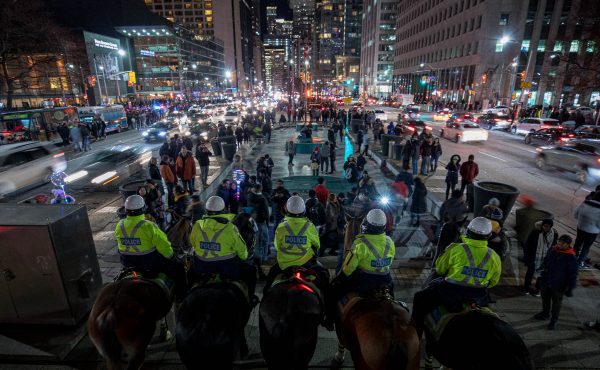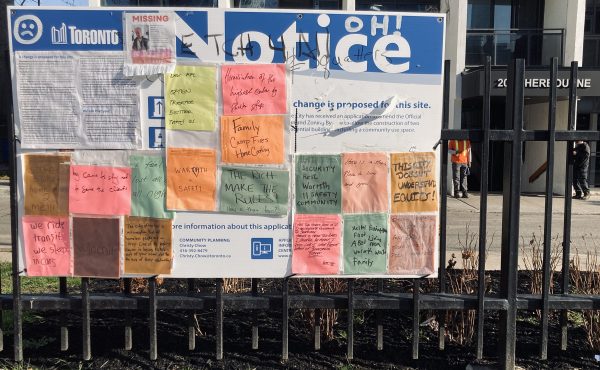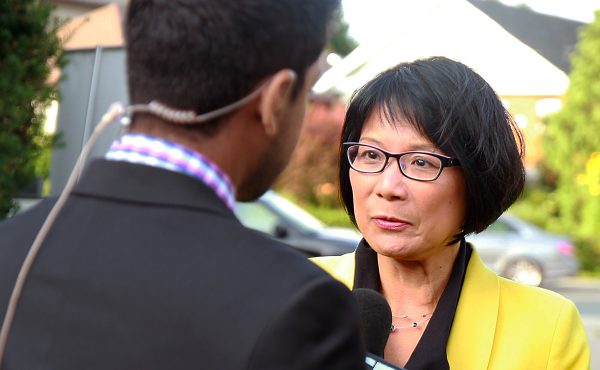

Did anyone hear Mayor Rob Ford so much as grunt a word of thanks, on behalf of all Torontonians, to his predecessor for backing a slate of policies that has brought the city’s murder rate down to levels not seen since the 1980s?
Didn’t think so.
In a bit of an ironic twist, our police-involved chief magistrate surely owes a huge debt of gratitude to Socialist Mayor™ David Miller for the latter’s role in the long-term improvement in Toronto’s violent crime rate, which crested in 2006 during the so-called year of the gun. And while he’s at it, Ford should toss a great big bone to the provincial Liberals for their role, which has also been significant.
Of course, Ford and his right-wing cronies will do nothing of the sort. But the record strongly suggests that the Miller/Bill Blair approach – a mix of community policing and outreach, preventative measures aimed at disenfranchised young people and broad-ranging, multi-agency investigations of gun-and-drug import operations – has clearly proven to be far more effective on the ground than Julian Fantino’s militaristic manner.
A little history is in order:
At the close of Mel Lastman’s term, police-community tensions in high-crime neighbourhoods like the Jane-Finch corridor were running very high, thanks in part to media revelations about racial profiling but also because of Fantino’s great love of coded language and racial insinuation. His most noteworthy response to the mayhem: the establishment of a guns and gangs task force.
In the 2003 mayoral race, Miller ran on an alternative approach to community safety, but was forced to make concessions about hiring more cops during the final weeks of the race as a spate of gun crime almost propelled rival John Tory to victory.
Early in Miller’s first term, then-rookie councillors Karen Stintz and Michael Thompson decided to push the reluctant mayor to take a tougher stance on gun violence. Miller’s officials smartly re-cast the debate by establishing the Community Safety Panel, headed by chief justice and youth advocate Roy McMurtry. After pledging funds for prevention-oriented programs. Miller orchestrated Fantino’s ouster, paving the way for Blair’s more ideologically simpatico brand of policing.
The Boxing Day shooting, in 2005, and the wave of gun violence that ensued for much of the following year, brought a more intensive responsive from provincial officials, who had already stepped up funding of guns and gangs-style enforcement. As this time-line explains, Dalton McGuinty’s Liberals, then in the throes of a love-in with the Miller administration, also anted up significant dollars for Blair’s Toronto Anti-Violence Intervention Strategy (TAVIS), which involved both intensive policing and community outreach in priority neighbourhoods.
The province, with other GTA police forces, continued to expand the guns and gangs task force, adding designated prosecutors and courts. After the 2007 murder of Jordan Manners, in a North York high school, Queen’s Park and the city further intensified efforts to get to the roots of youth violence in low-income communities.
All the while, the Miller administration, with backing from Queen’s Park, boosted not only funding for the Toronto Police Service, but also acceded to Blair’s requests for more beat cops. As the city’s budget documents reveal, the TPS gross expenditure grew from $669 million in 2003 to $830 million in 2007 and finally hit $956 million by the final year of Miller’s second term.
Everyone knows the story about the growth of the police budget. The head count story, however, is more interesting: In Mel’s last year, the police force had 7,288 full time equivalents, 5,245 front line officers and a crime problem. By Miller’s last year, the overall staffing levels had jumped 8%, to 7,877, with a 6.5% increase in uniformed officers (5,588). That figure included city funding for an additional 204 cops hired as part of the Miller/Blair community policing agenda, and another 30 designated to work directly in high schools.
Soft on crime? Don’t think so. Indeed, the Miller years closed with year-over-year declines in gun violence, and that pattern has continued, thankfully, in 2011.
Any assessment of this period should include a few important caveats: One, while the TAVIS/guns-and-gangs approach does produce arrests and charges, it doesn’t always yield convictions. Two, some cases, including a few really notorious gang-style murders, including Manners’, remain unsolved. Three, while the TPS under Blair has made a bone fide attempt to become a more culturally diverse, outwardly-oriented organization, its reputation took a big hit during the G20.
Lastly, as Blair once told me, the police have to be cautious about taking credit for declining crime rates because if they do, they’ll also be expected to accept the blame for rising crime. The reality is often much more complicated.
All that said, the moral of this story is that the city’s current approach to violent crime appears to be a pragmatic, expensive, but ultimately effective amalgamation of intensive policing techniques and preventative programs designed to address the root causes. In other words, a compromise.
Do the brothers Ford get it? Unlikely.
Still, the mayor can’t get rid of Blair (yet), and has failed to persuade the police service to accept a budget cut. But as for the prevention/community safety side of the equation, well, we all know what’s coming.
So here’s the big question: Where will those homicide and gun violence statistics be a year from now, or, more relevantly, in 2014, once the Fords have finished saving Toronto homeowners from all those porcine bureaucrats?
Put it another way: will there be blood in that gravy?




9 comments
Don’t worry, the feds are busy building more prisons.
Next, workhouses.
It’s unlikely that conservative ideologues will embrace Miller/Blair’s anti-crime legacy. Remember, after Julian Fantino’s contract was not renewed, the Toronto Sun responded by portraying Miller as Hitler. More likely, the objectively-verifiable success of this approach will fall down a cognitive black hole than considers anything new or progressive to be a form of “police-bashing.”
Well said. Time will tell.
Sorry John but violent crime statistics are down across the country in fact across the continent. This has been attributed to a declining younger population ie not so much testosterone floating around. I don’t think Miller’s social engineering policies have had a lot to do with what is happening elsewhere in the country. But then again you never can tell.
@Patrick Demographics may play a part in falling crime rates, but those changes tend to show up over a longer time period. And there are also communities which go counter trend: Edmonton, for example, and Peel Region.
There have been 3 murders in 3 days this year. Toronto’s crime rate is still way too high and needs to come down. We should not have neighbourhoods like Jane/Finch, Regent Park, Keele/Eglinton, Rexdale where it is too dangerous to go for a walk. We need more police & more social programs for low income people to reduce the crime rate in these neighbourhoods. We need to do something about the high crime rate in Mississauga/Brampton as well, crime has gotten to be quite high there these days.
@ Andrew… a lot of the gang bangers that live in the neighborhoods you reference might have had a better shot at growing up as responsible adults who contribute to society if their parental role models had been stronger. While I don’t disagree “that it takes a village to raise a child” the primary responsibility lies with the parents. More police on the street in desperate neighborhoods and dumping more money into social programs that really don’t address the issues, while convenient as a raison d’etre, is not a panacea. Just my opinion.
@John… while I don’t disagree with your point I think if you were to look closely at the two areas you reference and you could include northend Winnipeg I think you will find a higher percentage of disaffected youth both immigrant and indigenous are skewing the numbers.
“bone fide”?